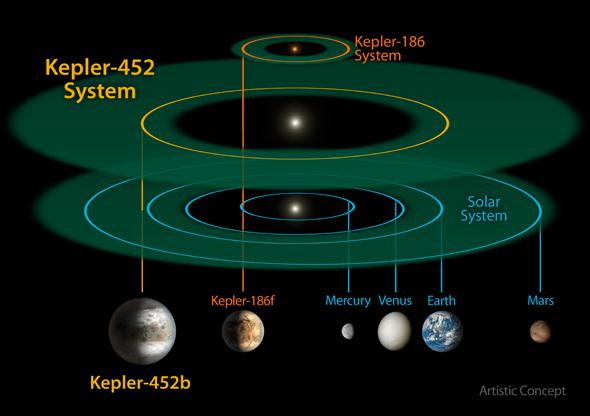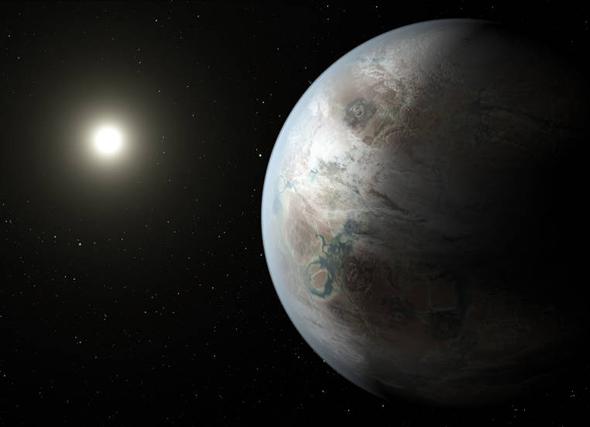One of the biggest goals in the search for exoplanets—alien worlds—is finding an Earth-size planet orbiting its star in the “habitable zone,” where liquid water might exist on its surface. In other words, finding another Earth.
So far, a dozen such planets have been found. All of those planets may be very much like Earth (we can’t be sure, as I’ll get to in a sec), but they orbit smaller, cooler stars than our Sun.
On Thursday, astronomers announced they have found another planet in its star’s habitable zone: Kepler-452b. But this one is different: It orbits a star much more like the Sun. The star and planet are about 1,400 light-years away.
The planet was discovered using what’s called the transit method; as it orbits its star, we see that orbit edge-on. Once every orbit, the planet passes directly in front of the star and we see a tiny dip in sunlight. The size of that dip tells us the size of the planet, and the time it takes tells us the planet’s orbital period.
Kepler-452b orbits its star at a distance just 5 percent more than Earth orbits the Sun, with a year 385 days long. While the star is similar to the Sun, it’s older, and stars brighten as they age. That means Kepler-452b actually receives more heat from the star than we do from the Sun, so it’s likely warmer than we are.
Note, though, that a couple of billion years ago the star was cooler, pretty much like the Sun is now. That means that a long time ago, 452b was getting the same amount of light and heat we do. Interesting.
This doesn’t mean the planet is Earthlike, though. For one thing, it’s bigger than we are: Its diameter is 1.6 times that of Earth. We don’t know its mass, unfortunately, and without that we can’t know its density. The density is what gives us our first clue about what the planet’s made of; water has a density of 1 gram per cc, but iron is 8. Rock is 2–3.
If the planet has the same stuff in it as Earth does, it’ll be more massive; four times Earth’s mass*. In that case, its surface gravity would be 1.6 times Earth. If you weighed 100 pounds on Earth, you’d weight 160 pounds there. But only if it’s rock and metal like we are. If it’s less dense (more rock) than, the surface gravity will be lower; if it’s denser (more metallic), it’ll be even higher.
It’s not clear what that means for a planet’s atmosphere. All other things being equal, more gravity means it can hold on to more gas, so the air there could be much thicker. If so—and remembering it’s receiving more light and heat from its star than we do—it might be suffering a runaway greenhouse effect. Or, it may not have any air at all. Or or or. Without more information, we can only guess.

Drawing by NASA/JPL-CalTech/R. Hurt
This is an exciting discovery, since this is the first exoplanet roughly Earth-size in the habitable zone of a star so much like our own. The last time we found one this good was Kepler-186f, which orbits a red dwarf. That planet is much closer to our size than 452b is, and may be more similar to us. It’s not clear there how orbiting a red dwarf would make it different. Would the atmosphere be different? If life existed there, how might it look?
I’m a little torn about this discovery. For decades we had no idea if other planets even existed around other stars. Now we know of thousands! And we also know of many that are the size of our Earth, meaning they aren’t too hard to make. In fact, we think there are billions of Earth-size planets in our galaxy alone! Most will be too hot or cold for life, or have other issues making them likely to be uninhabitable.
Searching for a planet with conditions as close to ours is a clear goal here. Kepler-452b is a big step in that direction.

Drawing by NASA/N. Batalha and W. Stenzel
But it’s not perfect. It’s bigger, the star is hotter, and so on. I suspect 186f might be more Earthlike, but again we can’t know for sure. So I don’t want to overhype this discovery.
We need bigger telescopes, ones capable of teasing out the planet’s light from the star’s, taking its spectrum, and analyzing that spectrum for tell-take signs of chemistry. From that we can gauge its temperature better, what it’s made of, and even if there are biological markers (like, say the presence of oxygen molecules, which are hard to keep around without biology). Until then, we just don’t know enough about these planets to say much more about them with certainty.
And I think what may be even more important is to see just how diverse Earth-size planets are! Some bigger, some smaller, some hotter, some cooler. The interesting point here is that nature is cooking planets with all sorts of different flavors here, and while looking into the heavens and seeking out one that looks like us is natural, we should also be careful to delight in the varying recipes out there.
The big question we ask is, Are we alone? The answer, I suspect, hangs on what you mean by “alone.” We are in a galaxy brimming with planets, many of which look like us, and many of which don’t. But even the ones that look different at first may be more like us than we know.
* The volume of a sphere increases with the cube of the radius. Since Kepler-452b is 1.6 times the radius of Earth, its volume is 1.6 x 1.6 x 1.6 = 4.1 times Earth’s volume.
